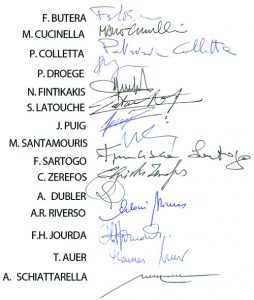Rome, 20 May 2011 by Francesca Sartogo with the collaboration of Angelica Fortuzzi

Διακήρυξη ΕUROSOLAR /UIA-ARES
Ρώμη, 19-20 Μαΐου 2011
Τhe architecture of well tempered environment an harmony of integrated instruments
PROLOGUE
We are living in a turning moment in our History, which urgently requires an effective action to contain the disastrous effects of Climate Change and the threats of “Peak Oil” and “natural resource depletion”.
This Manifesto recognizes the significance of the European Charter for Solar Energy in Architecture and Urban Planning (1996), and intends to reaffirm its content in accordance with the European Directive on nearly zero energy buildings, the latest European and international documents on strategies for Sustainable Cities and Environment.
We strongly believe that Architecture and Urban Planning have a leading role for the formal and functional quality of our future, social and natural environment, and to ensure survivable levels of comfort and well-being, it is unavoidable and urgently necessary that the design is the result of a harmony of well-tempered environment.
It will be necessary to reformulate the approach by which we act on built environment and nature, and as professionals, planners, architects and engineers, assume the responsibility of our role.
To reach these aims it will be necessary a reformulation of the architectural language and roles in time, in space, in mobility and in technology and in terms of “structure, grammar and syntax”, reaffirming the relevance of Vitruvius “firmitas, utilitas, venustas”.
Therefore we believe in the need of acting in the fields of:
Energy
Environment
Architecture
Ccity
Education
The professions
Governance
10 key actions
- Designing buildings from the requirements of thermal, light and sound comfort, providing architectural solutions that guarantee buildings free of non-renewable energy, provided by technological efficient systems and powered by renewable energies.
- Designing cities based on the integration of functions – home, work, services – to encourage pedestrian and bicycle mobility, reducing pollution and private car use.
- Pursue the development of distributed renewable energy, network and storage systems in the design of buildings, neighbourhoods and cities.
- Reformulate the rules and approaches, increasingly complex, of the Architectural and Urban Design to include the necessary multidisciplinary skills useful for the organic development of the project; restore the links between aesthetics, technology and function towards an environmental approach.
- Promote the Integrated Design, both through the changing role of the architect “to integrate skills”, both through the design process that comes from the organizing and enhancement of an harmony of multidisciplinary contributions for climate, environmental and cultural equilibrium.
- Pursue the integration between natural and human ecosystems – nature, history, cultural identity, social and economic aspects, morphological characteristics – ensuring that developmental processes by humans, aimed at fossil-fuel free food production, soil and wetland restoration and land conservation, become part of our future.
- Ensure through innovations and technologies to achieve the maximum possible in energy efficiency, in this architecture should play a proactive role to stimulate technological innovation, environmental friendly and compatible with the local “milieu”.
- Promote scientific and technological experimentation involving universities, professional firms, local governments and industries in order to develop a repertoire of effective energy saving techniques, technologies and tools.
- Promote and disseminate new technical and scientific culture through training in close cooperation between universities and professional associations.
- Seek the political commitment of governments and institutions at all levels, to engage in the realization of these goals through appropriate instruments and policies.
